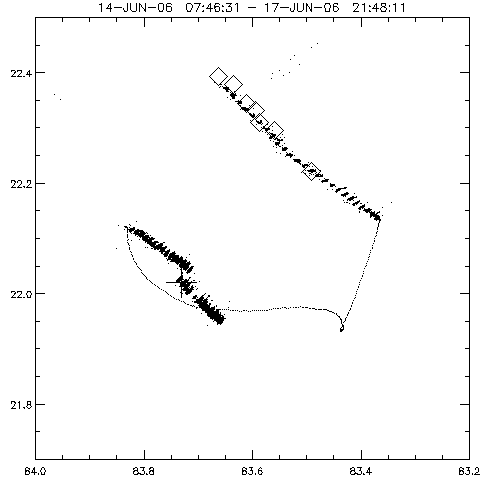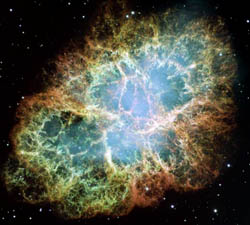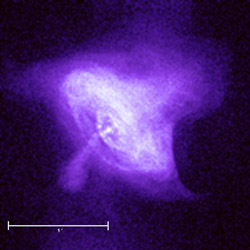RHESSI's non-solar observations
RHESSI has some powerful capability for observing non-solar X-ray and
γ-ray sources, as discussed in previous science nuggets on a
fortuitously-observed magnetar.
Another fortuitously-observed X-ray
pulsar has not yet been described, but it (like the magnetar)
chose to get bright just as it conveniently approached the Sun.
The Crab Nebula
(M1 in the
Messier catalog of celestial fuzzy things) is not serendipitous.
Every year in June RHESSI sets out to observe it during its time of closest
(apparent) approach to the Sun.
Eventually these observations will result in a sort of movie of the hard
X-ray structural variations of the hard X-ray Crab, at the RHESSI arc-second
angular resolution.
These will be the first hard X-ray imaging observations of the Crab Nebula
since the pioneering imaging observations by L. E. Peterson's group from balloon-borne
telescopes, plus some lunar-occultation observations.
In the meanwhile this nugget explains how we do the observations with RHESSI.
This is not as easy as it might seem, since
the RHESSI spacecraft is designed to look at the Sun and nothing else.
Here's the quarry:
Figure 1: (left) A mosaic view of the Crab Nebula in visual light,
taken by the
Hubble Space Telescope.
This image is about 0.1 degrees wide; the hazy blue glow in the center
of the nebula results from
synchrotron radiation caused by relativistic electrons accelerated
in the expanding supernova envelope. (right) A Chandra Observatory
soft X-ray image on a magnified scale.
How does one point a spinning spacecraft?
One essential problem is that RHESSI spins around its telescope axis.
The unbalanced angular momentum of the rotation (at about 4 sec period)
stabilizes the pointing direction intentionally; to change it one
must apply an external torque T with a component perpendicular to the
spin axis, which will cause the spacecraft to rotate around that component
while conserving the total angular momentum L.
As anyone familiar with gyroscopic forces knows, this is very complicated.
Space
flight provides wonderful opportunities to study these motions at
leisurely time scales because of the weakness of the perturbing torques.
A natural source for an external torque on a spacecraft, commonly used in
situations like this, is the Earth's magnetic field. A current is passed through
magnetic torque bars which
react to the Earth's magnetic field (since F = qv x B).
This works best if the
satellite is near the Earth, since the field strength falls off very rapidly.
But there is an additional problem: RHESSI is spinning, so any torque
derived from the field will average to zero in first order.
The solution to this problem is to provide the
torque bars a modulated current in phase with the spin motion.
In this fashion one can create an unbalanced torque.
But one must compute the spin phase with great precision if one wants
to go very far from the Sun to a specific target (e.g., the Crab).
That is one of the problems that has made this difficult.
Amazingly enough, the complicated structure of hardware and software
(some of the latter documented best in the manner of the
oral tradition) actually works:

Figure 2: RHESSI approaches the Crab Nebula!
The dots show the spin-axis location, i.e. the pointing direction of the
telescope; the big plus sign is the location of the Crab.
Coordinates are (RA, dec) in degrees, and
the time interval is about three days.
The diamonds show pointing offsets determined directly from imaging the X-ray
source detected by RHESSI, and confirm the pointing as measured by RHESSI's simple
quadrant-cell Sun sensor.
The odd thin sigmoidal curve shows RHESSI's reaction to re-pointing torque
commands, as it slews closer to the target.
The drift: a puzzle
As with previous years of offpointing RHESSI, mainly for the Crab Nebula
but also for the pulsar
A0535+262, we have seen some unexpected behavior.
As any experimentalist knows, it is always a battle to get things to work
right, and the pointing plot (Figure 2 above) displays some of our ignorance.
We actually do not know the origin of the perturbing torques that causes
RHESSI to change its pointing during "idle" conditions, when it is not deliberately
applying magnetic torques for slewing or pointing control.
There seem to be four possible candidates: first, there could be
magnetic torques due to the routine operation of the spacecraft, which
requires large currents to flow throughout the spacecraft.
Yet these would not be phase-resolved in the spin motion, so to first order
they should cancel out.
There are also always also gravity-gradient torques, dependent on the mass
distribution of the spacecraft.
Another possibility is differential air drag.
In low Earth orbit there is still quite a bit of atmosphere, mainly monatomic
oxygen, and its density fluctuates strongly in space and time.
Finally, there is radiation pressure, which would apply a torque if the center
of gravity did not match the geometrical center (in some sense) of the spacecraft.
There may be other mechanisms at work, so if an expert reads this, please
feel free to straighten us out! This can be done (for example) on our blog.
Success!

Figure 3: An RHESSI snapshot image of the Crab Nebula using only the coarse
(low resolution) grids. This image, with excellent SNR, shows a point source.
As we learn how, we will be making images with much better angular resolution
and expect thereby to see features that can be related (for the first time
in hard X-rays) to the structure one sees at other wavelengths.
In the end, the 2006 Crab adventure was a success.
Above is a "snapshot" image, representing only 30 minutes of accumulated data, using
three of the nine RHESSI detectors. The structure of the nebula is unresolved using these detectors.
Biographical note:
Bryna Hazelton led the RHESSI observations of the Crab Nebula in 2006.
She is a graduate student at UC Santa Cruz, working with David Smith.
Observing the Crab Nebula is a special kind of thing for RHESSI, and
many people have contributed to an annual (well, almost) success.
This year's team consisted of Bryna, Martin Fivian, Hugh Hudson, Gordon
Hurford, Mark Lewis, Jim McTiernan, David, and Jeremy Thorsness.
In particular Gordon and Martin developed pointing and position-measuring
software that ordinary astronomers can actually use.
Dave Pankow first determined how RHESSI's angular momentum would work,
and then tried hard to explain it to the rest of the team.



